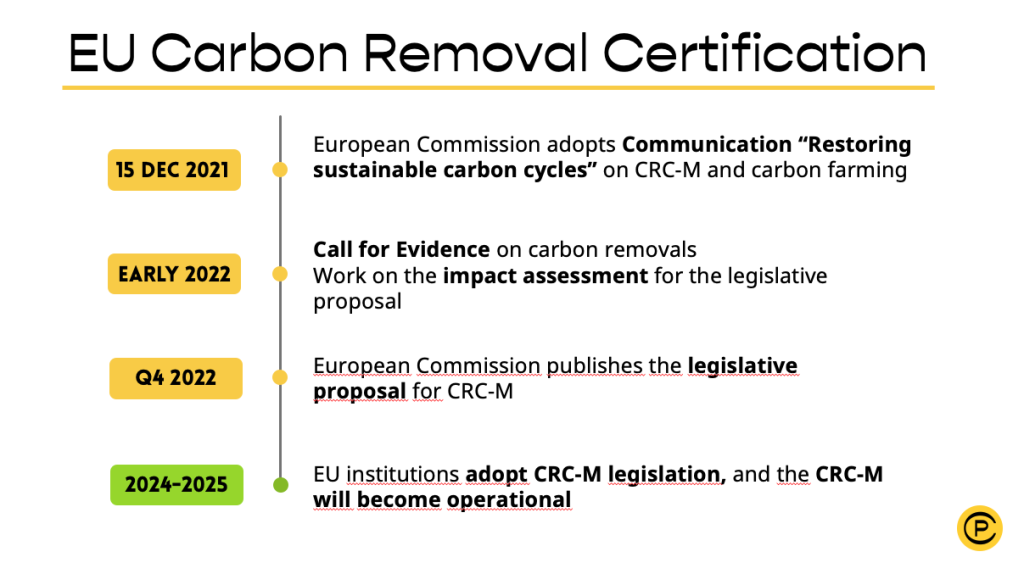
Europe is finally tackling the missing part in its climate policy toolbox – carbon removal. Next to steep emission reductions required over the next couple of decades, carbon removal will become the main driver of climate ambition before mid-century. In their Sustainable Carbon Cycles Communication, the European Commission outlines its vision as follows:
“To reach the climate neutrality objective of the EU Climate Law, carbon removals will have to be fully integrated into EU climate policy.“
European Commission, Sustainable Carbon Cycles Communication, 2021
As with other climate policy initiatives in the past, the first step is to establish robust monitoring, reporting and verification framework. You can only manage what you measure – and measuring is currently a challenge for many carbon removal approaches. This time, it’s called the carbon removal certification mechanism (CRC-M). CRC-M will quantify carbon flows, ensuring that carbon dioxide is “unambiguously removed from the atmosphere” and permanently stored. This, in turn, helps to steer financial flows and enables to use of carbon pricing mechanisms like voluntary and compliance carbon markets to incentivise carbon removal.
There is a willingness to incorporate removals under the EU compliance frameworks post-2030. And to be ready in time, “by 2028, any ton of carbon dioxide captured, transported, used and stored by industries should be reported and accounted by its fossil, biogenic or atmospheric origin“.
Scope and targets – domestic carbon removal
The EU needs to capture between 300Mt and 500 Mt of carbon dioxide from waste, sustainable biomass and directly from the atmosphere to become climate neutral by 2050 (Sustainable Carbon Cycles Communication). This is in addition to the net removals target of 310 Mt by 2030 under the Land Use, Land Use Change and Forestry regulation proposal, for which carbon farming will contribute (“carbon farming initiatives should contribute to the increase by 42 Mt CO2eq of the land sink that is required to meet the objective of 310 Mt CO2eq net removals by 2030”).
The Commission puts forward two aspirational targets. 5Mt of carbon dioxide should be annually removed from the atmosphere and permanently stored through projects (like direct air capture and carbon storage) by 2030. At least 20% of the carbon used in chemical and plastic products should originate from sustainable non-fossil sources by 2030. Such targets are vital for many reasons, including creating certainty for investors and guiding governments in their national policy design.
A clear indication of financial tools for the uptake of industrial carbon removals (EU Innovation Fund, Connecting Europe Facility, carbon certificates for difference) and carbon farming (CAP, LIFE, cohesion policy, state aid) is very welcome. So is a strong recognition of the importance of carbon dioxide transportation and storage infrastructure. Without an EU-wide transport and storage plan, carbon removal won’t be available to contribute to the climate neutrality target fully.
The EU shifted its climate policy scope to domestic EU targets during the last decade. There are two main reasons behind this change. First – it is a political choice, primarily derived from the negative experience with the international credits in the EU Emissions Trading System (EU ETS). Now that the EU ETS is functioning as it’s supposed to, and some even find that it is performing too well given the current carbon price level (December 2021), there is a good reason to safeguard this sophisticated system which took over 15 years to build into the success it is today.
The second reason is plain climate math. If every country, or supranational entity like the European Union, would keep relying on emission reductions and removals from abroad, the inevitable question would eventually arise – who will do the hard work? It can’t be the developing countries. If the EU is to lead by example, it will need to achieve climate neutrality by itself. This is what is enshrined in the EU’s 2030 and 2050 targets in the Climate Law, and this is what the carbon removal certification mechanism will complement by following the same scope.
Strong focus on integrity
The main challenge of carbon removal is accounting. It needs to be absolutely clear that carbon dioxide is removed from the atmosphere, that it is stored out of the atmosphere permanently, and emissions are not increasing elsewhere through carbon leakage. The need for robust monitoring, reporting and verification features strongly in the document, and it remains to be seen how this will be implemented in practice. There is a wide range of stakeholders keeping an eye on the robustness of the rules.
Where are we in the process?

The European Commission’s Sustainable Carbon Cycles Communication is not a legislative act; it’s a document that sets out Commission’s vision. A good example is the European Green Deal Communication, possibly the most famous Commission Communication from the last years. It put forward the climate neutrality target for Europe by 2050. Still, the target itself was later adopted in the European Climate Law through a full-fledged legislative procedure with the EU Member States and the European Parliament.
The next steps will include a Call for Evidence in early 2022, a lot of work on the impact assessment for the legislative proposal on CRC-M, the proposal’s publication at the end of 2022, and its adoption probably somewhere around 2024-2025.
Leading the way in the global carbon removal policy scene
The Commission is not modest: “Being a pioneer in the regulatory certification of carbon removals will make the EU the trailblazer.” And it is true. Carbon removal has a clear role in the global climate mitigation policy, most notably in the Paris Agreement, including the carbon markets under Article 6. Still, there is a lack of robust monitoring, reporting and verification rules for many carbon removal approaches. The EU is currently the frontrunner with their work with the CRC-M. If executed well, this will serve as an example globally.
***
Thank you for reading! Sign up for updates below, and stay tuned for the next posts.
Would you like to use (parts of) the text? Go ahead on the condition that you explicitly refer to this post and include a link.
Thank you!
